Marks Ba to Bg
(c) Antique Metalware Society
Small extracts can be used with acknowledgements to 'Oldcopper.org' website.
Helpful comments are very welcome.
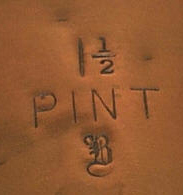 |
‘B’ unidentified mark on tankard, information welcome. |
 |
'B Ltd.', an unknown mark on a brush. |
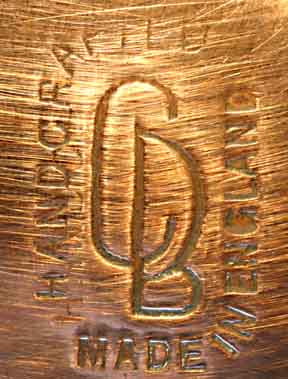 |
CB Handcrafted, Made in England, unknown mark found under plain copper and brass dishes that have three ball feet. |
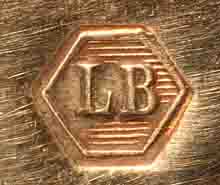 |
LB - unknown mark found under a 1930s brass vase. |
| B L & S B | Marks L Lilley & Sons |
E. B. |
Earle Bourne, Birmingham Marks E |
 |
'SB' with crown and 'No 3' under a candlestick. Swedish Copperware |
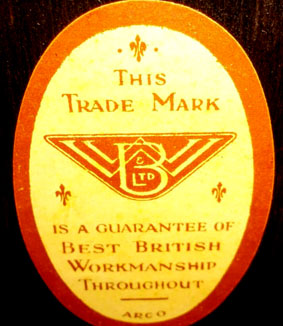 |
'WB Ltd.' mark under a photo frame with the name of Arco, Birmingham. More information will be welcome. An earlier use of these initials is under cast brass candlesticks by Williams Bros. |
 |
Badelows, Birmingham, coppersmiths. More information welcome. This mark on the handle of a saucepan lid. |
| Bailey Gill, | - see Leslie & Co. Marks L |
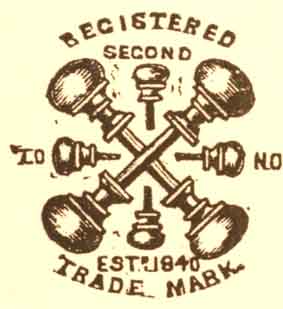 |
Bailey and Mackay, Durable Works, 173 & 174, Great Hampton Row, established 1840 and at that address until after 1943. Their trademark was crossed door knobs with infill with the slogan 'Second to None' found sometimes on architectural brass foundry, lock and latch furniture. By 1956 they were at 7, Baltimore Road, Great Barr, making pressure gauges. |
| William Henry Bagley | (renamed from Stampings Alliance Ltd., c1900) hot stampers of Argyll St., Nechells) Viaduct Works, Aston, Birmingham. |
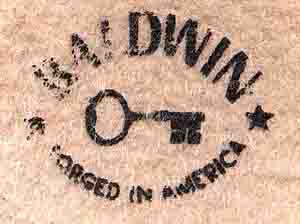 |
Baldwin Brass, Continuing modern production of architectural hardware in Reading, PA, USA http://www.baldwinbrasshardware.com/index.htm |
| Bancroft Brothers | die sinkers, had premises at 170, Hockley Hill, Birmingham, from 1871-1910. |
| Banks Brownsey, Guernsey Jugs. | Illustrations Guernsey & Jersey Jugs (Creamers) |
| Barker & Allen Ltd. | Spring Hill, Birmingham, B18, founded 1883 from the 1840 Stephen Parker Company. They specialised in making nickel silver (German silver) and bronze strip and wire with up to 300 employees. They were taken over by Enfield Rolling Mills in 1958 so then became part of Delta Metal Co. from 1963 until sold to Evered Industrial Products (EIP) in 1991. |
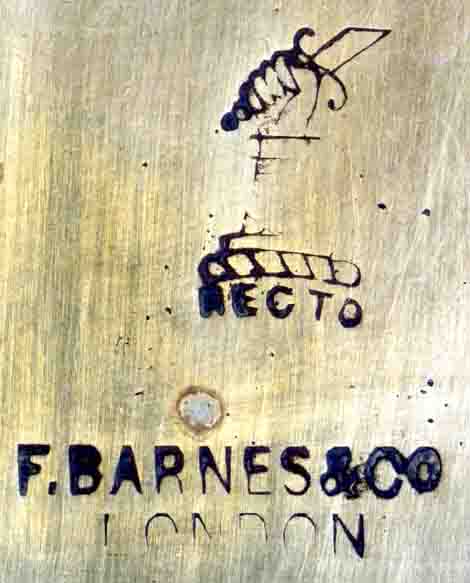 |
F Barnes & Son, London, mark on 18th century decorative stirrup. |
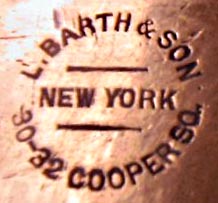 |
L Barth & Son, 30 - 32 Cooper New York, copper cookware. (lok1800) Leopold Barth was born in Bladdin, Bohemia on 4 December 1842. He immigrated to the U S in 1868. He is listed in the 1877 New York City Directory as a tinsmith. In the 1880 New York Census he is shown with a retail crockery store. His occupation on his 1884 U S Naturalization Petition was tinsmith . He is listed in New York City directories with the occupations hardware merchant, stoves, furnishings and crockery. Leopold died 4 June 1921. (Thanks to Patrick D. Dolan) |
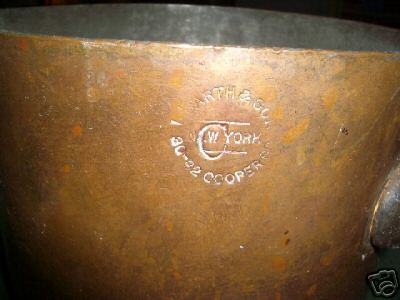 |
Another Barth mark, courtesy Matthew Elliott. |
 |
James Barwell, Fiddian Foundry, Great Hampton St, Birmingham, Cock (tap or faucet) founders and bellfounder making sizes from handbells to church bells from 1842-1971. James Barwell had acquired Fiddian's firm of 'Steam and Water' in 1842 and retained the trade name. (Thanks to Charles Barwell) Their name is found round the top of some bells. 'Fiddian' is sometimes stamped on bell handles. 'JB' is frequently found on the bell shoulder. This mark on a 1939 air raid warden's handbell is also stamped with 39 for the year. |
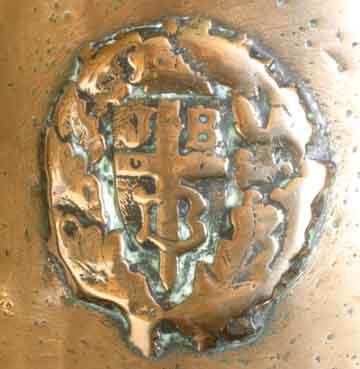 |
This mark on the side of a 50lb bronze bell shows 'JB' initials either side of a cross entwined with a 'B' in an oval of oak leaves (for Birmingham). It is the maker's mark of James Barwell in the place otherwise often used for the owner's name or crest. Customers could request bespoke crests or inscriptions. (Thanks to Alderman Peter J P Barwell, grandson of James Barwell and former Lord Mayor of Birmingham). |
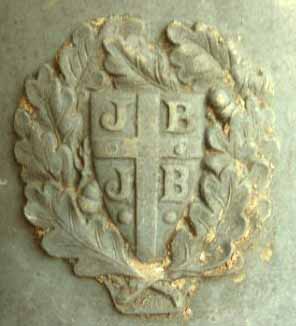 |
For information on other bellfounders see the Bell Historians website. A similar shield found on a church bell in Sydney, Australia. The church was built in 1896. (Thanks to Robert Hinchcliffe). |
 |
Bates and Klinke Inc, Attleboro, Mass., USA. This mark under a brass ashtray. Immediately before World War I, Harold Bates was employed as a hub and die cutter by Thomae Co, and Oscar Frederick Klinke was employed by August V. Friemalhner also as a hub and die cutter. By 1919 they were listed as hub and die cutters and in the partnership of Bates & Klinke. They were also steel stamp and emblem makers as well as jewellers. (Thanks to Patrick D Dolan) |
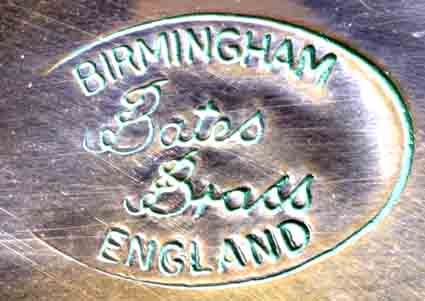 |
Bates Brass - Bates & Sons. 77 Spencer St., Birmingham B18 6DE relatively recent production of items such as trays and souvenirs. Possibly successors to Bates & Follows of 52, Frederick Street, Birmingham, 1970s. Later products had paper labels instead of a stamped mark. More information welcome. |
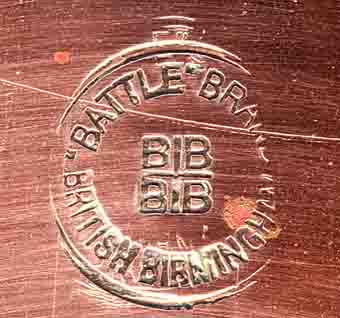 |
Battle Brand, G W Pearce & Sons Ltd., 158 Chester St., Birmingham 6, from c1900 to c1995, holloware manufacturers, makers of good copper cookware for home, commercial and industrial uses. Other metals also used. (Thanks to Brian Hunt) |
| Bayley & Street, Thomas Bayley and Robert Street, brassfounders of Bridgewater, Somerset, c1750. This skillet handle is on a recent reproduction. | |
| Beacon Brassware | - see Smith and Davis Marks S |
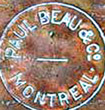 |
Paul Beau, Mountain Street, Montreal, Canada (1871-1949). A metalsmith in Arts and Crafts style, frequently mixing metals in a piece to obtain colour contrasts. Later pieces may not have '& Co. |
| Beldray, Wolverhampton | – see Bradley and Co., Illustrations Beldray |
| Benedict Proctor Mfg. Co. | |
| Flemish Copper B.P. Co. | Benedict |
| Benetfink & Co., | Cheapside, London, retailer as Benetfink & Jones (c. 1845-1851), Benetfink & Co. (1852-1861), Benetfink & Fox (1862-1866) and again Benetfink & Co (1867-c.1900). |
| H Benham, Benham & Sons, London | later at Strafford House, Strafford Place Birmingham B12. - Cookware (1959 Kelly) (The 'Belt' logo may not have been an official stamp |
| Benham & Froud, London | Benham Froud. |
| Benson, W A S, London, | Four marks Illustrations WAS Benson |
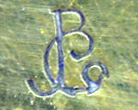 |
J. J. Bent & Co, Charlotte Rd, Stirchley, Birmingham, brassfounders, later Bent & Parker Ltd., of Harpers Hill Works, Northwood St., St. Pauls, Birmingham (c1900) then Pembroke Street Works, Worstone Lane, making belt buckle and bracelets. Photo of a possible mark submitted by Toby Pinn. |
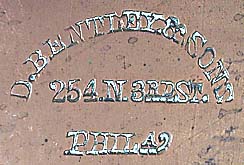 |
D Bentley & Sons, 254N Brd St Philadelphia. Copper cookware. (Thanks to John Mason of Lexington, Ky.) D (David B) Bentley & Sons coppersmiths were at 252 N 3rd St, Philadelphia, Pennsylvania from the early 1860's into the 1870's. There was another David Bentley and Sons coppersmiths in the first half of the Nineteenth century at 162 N 3rd St, Philadelphia, Pennsylvania. Judging by the ages of David B Bentley sons, they were probably the preceding generation. (Thanks to Patrick D. Dolan.) |
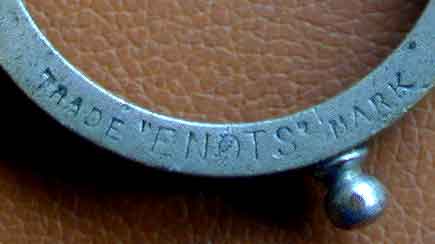 |
Benton and Stone, Bracebridge Street, Birmingham, (ENOTS) Art Metalware, gas fittings, sprayers and, later, motor car accessories (1901 Kelly). By 1926 they were at 6, Aston Brook Street (tube works) and Witton Road. 'Enots' is of course 'Stone' backwards. This photo by Peter Grantham. |
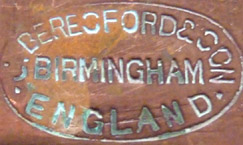 |
Beresford and Son, Cato Street Works, Birmingham 7, manufacturers of brassfoundry, spring hinges, pumps and other hardware for railway cariiages and general purposes Moved to Marston Green c1951. This mark on a late 19th century handle. |
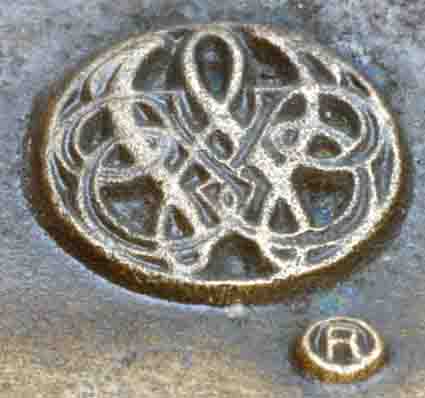 |
Bergamot Brass Works, Darien, WI, brass belt buckles and brass plated zinc diecastings. |
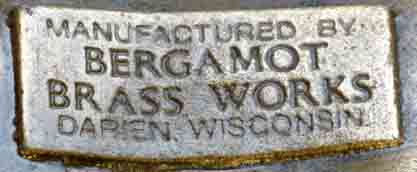 |
|
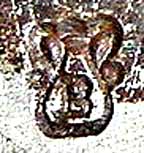 |
Franz Bergmann, Viennese bronze founder, started around 1860. The company worked well into the 20th century. (Thanks for the ID to Tom of 925-1000.com. Photo courtesy Mary & Tom Reed). |
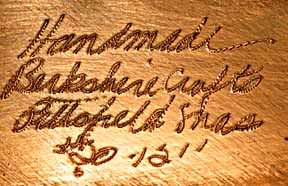 |
Berkshire Crafts, Pittsfield, Massachusetts. This mark under an elegant copper charger. More information welcome. |
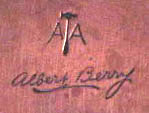 |
Berry, Albert Albert Berry's Craft Shop (Berry's Craft Shop), Seattle, WA. By 1905, Albert Berry was a Klondike miner based in Fairbanks, Alaska. By 1913 he moved to Juneau Alaska and opened an Arts and Crafts Shop, designing and making custom artware reflecting the local folklore and using the ‘AA’ mark to represent ‘A;aska Artisans Arts and Crafts Shop’ which lasted until 1918. He set up ‘Berry’s Handicrafts Shop’ at 1210 Fourth Avenue, Seattle in 1918 making well-designed, useful domestic copperware and also using brass, silver, gold and glass. Albert died in 1949 and the shop was moved to 93, Marion Street, Seattle until it closed in 1974. Three marks are known – AA either side of a hammer, a similar mark with his signature and, later, a ‘B’ with a the upright formed by a hammer and surrounded by the Berry name and Seattle. |
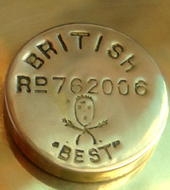 |
|
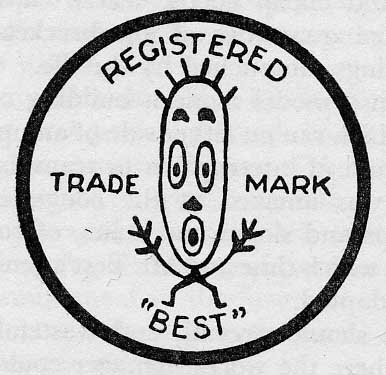 |
Best & Lloyd, Cambray Works, Wattville Road, Handsworth B21, brassfounders, light fittings, formed in 1867 after the liquidation of Best & Hobson. (Ref: 'Brass Chandelier', R. D. Best, George Allen & Unwin, 1939, 251pp., a biography of R H Best.). They are still in business with their main office by the works at 51, Downing Street, Smethwick, Birmingham B66 2PP. (Photo courtesy Martyn Fenwick) The 'Best' Trade Mark registered after the formation of the limited company in 1898, promoting the 'Surprise' pendant light. |
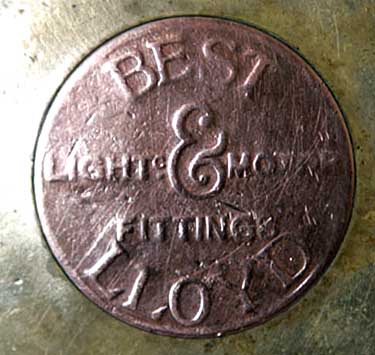 |
|
 |
Bevan and Fleming, patentees and makers of the 'Thermoterion' part insulated lidded copper jug. Maker's address unknown - information welcome. |
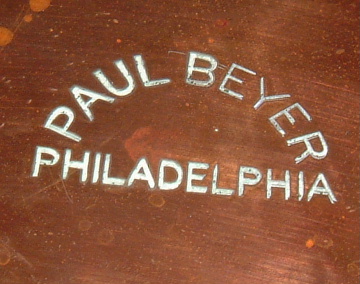 |
Paul Beyer, Philadelphia, this mark under a small tray. He was born 16th January 1877 in Germany and emigrated to America, being naturalised in 1907 and set up a workshop at 834 N 4th St., Philadelphia with a home at 1021 Glenwood Avenue. By the time of the 1930 census he was employing Paul his son as an apprentice coppersmith. (Thanks to Pat Dolan) |
Home.